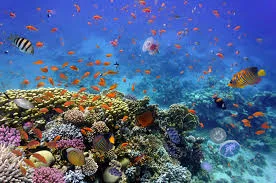
Why in news?
- The vast expanse of the ocean, teeming with life and underpinning the planet’s health, faces unprecedented threats. Overfishing, pollution, and climate change are pushing marine ecosystems to the brink.
- In response, a new paradigm is emerging: the Regenerative Blue Economy (RBE).
- It’s not just about sustainable use of the ocean’s resources; it’s about actively reviving and restoring its vibrancy.
The Hierarchy of the Blue Economy: From Extraction to Regeneration
- A report by the International Union for Conservation of Nature (IUCN) outlines the roadmap for this transformative approach. It proposes a hierarchy within the Blue Economy concept, with RBE at the pinnacle. Here’s a breakdown:
- Ocean/Brown Economy:
- This represents all ocean-related activities, like shipping and fishing, with a “business-as-usual” focus on economic gains.
- Sustainable Blue Economy:
- This incorporates environmental protection and ecosystem well-being alongside economic activity.
- Regenerative Blue Economy:
- RBE goes beyond sustainability. It actively seeks to restore marine ecosystems, promoting low-carbon economic activities and ensuring prosperity for people and the planet.
- Ocean/Brown Economy:
The core principles of RBE are:
- Protection and Restoration:
- Regenerating and safeguarding marine ecosystems, their resources, and natural capital is paramount.
- This includes combating climate change and biodiversity loss.
- Inclusive Economic System:
- Everyone benefits. RBE fosters inclusivity, fairness, and solidarity, ensuring well-being, resilience, and reduced vulnerability to climate change, supported by sustainable funding mechanisms.
- Inclusive and Participatory Governance:
- Transparency and participation are crucial. RBE calls for a governance system that integrates adaptable legal and regulatory mechanisms into international agreements.
- Low or No Carbon Activities:
- Prioritizing activities that have a positive impact on ecosystem regeneration and local well-being, with a focus on low or zero-carbon approaches.
- Priority Implementation in Island States:
- Island nations with specific needs are a priority for RBE implementation. Recognizing the traditions and needs of coastal populations, particularly Indigenous communities, is vital.
- The IUCN report acknowledges different levels of sustainability within the Blue Economy concept. RBE stands out as the most ambitious and restorative approach, actively reviving ocean health.
- While various organizations have proposed Blue Economy principles, some common themes emerge: healthy ecosystems, sustainability, inclusivity, and good governance.
- Importantly, the report emphasizes the need to connect RBE with the circular economy, bioeconomy, and Social and Solidarity Economy (SSE). These approaches promote resource efficiency, biological resource utilization, and prioritizing social and environmental goals alongside economic ones.
Blue Carbon: A Natural Ally
- The report highlights the significance of “Blue Carbon,” the carbon stored in coastal and marine ecosystems like mangroves, seagrass meadows, and tidal marshes.
- These ecosystems are powerful carbon sinks, storing more carbon per unit area than terrestrial forests. Protecting and restoring them is crucial for mitigating climate change and achieving emissions reduction targets.
- The IUCN actively supports Blue Carbon initiatives through funding mechanisms that pave the way for private sector investment.
Examples and Initiatives
- Several global initiatives promote RBE:
- IUCN Nature 2030: This comprehensive plan aligns with the UN’s sustainable development goals and the post-2020 global biodiversity framework.
- The Great Blue Wall Initiative: Spearheaded by African nations, it aims to protect vast ocean areas, restore critical ecosystems, and promote a regenerative blue economy that creates jobs and empowers local communities.
- Clean Seas Campaign: Led by UNEP, this campaign tackles plastic pollution in the ocean.
- India, too, has embarked on initiatives aligned with RBE principles:
- Maritime India Vision 2030: This aims to develop a robust maritime economy.
- Deep Ocean Mission: This mission focuses on ocean exploration and resource development, emphasizing sustainability.
- Pradhan Mantri Matsya Sampada Yojana: This scheme aims to enhance fish production and improve the lives of fishworkers.
- Integrated Coastal Zone Management (ICZM): This program promotes the balanced use of coastal resources.
- Blue Economy 2.0: This initiative builds upon previous efforts, aiming for a more holistic and sustainable approach.
The Way Forward
- The Regenerative Blue Economy offers a beacon of hope for our oceans.
- By actively restoring marine ecosystems, promoting sustainable practices, and ensuring equitable benefits, RBE can chart a course towards a healthy ocean and a thriving blue future for all.
People also ask
Q1: What is the Regenerative Blue Economy (RBE)?
Ans: RBE goes beyond just sustainable use of the ocean. It’s an economic model that actively seeks to revive and restore marine ecosystems, while promoting low-carbon economic activities and ensuring prosperity for people and the planet.
Q2: How is RBE different from the Sustainable Blue Economy?
Ans: The Sustainable Blue Economy focuses on using the ocean’s resources responsibly and minimizing environmental impact. RBE takes it a step further by actively restoring and regenerating marine ecosystems.
I don’t think the title of your article matches the content lol. Just kidding, mainly because I had some doubts after reading the article.
I don’t think the title of your article matches the content lol. Just kidding, mainly because I had some doubts after reading the article.